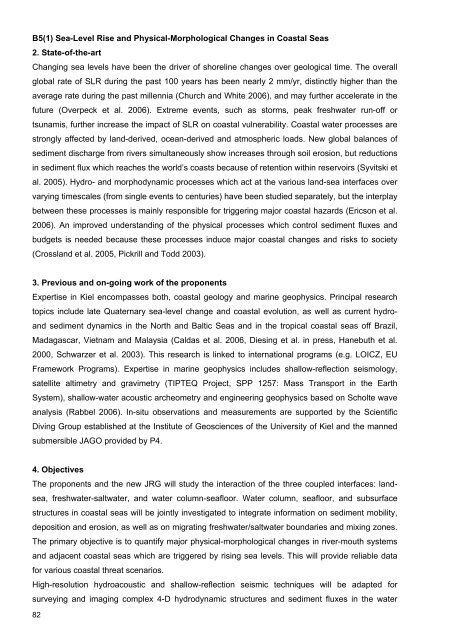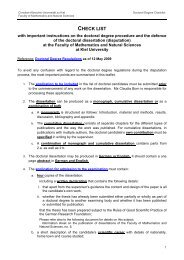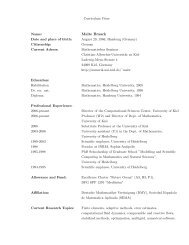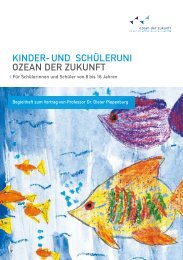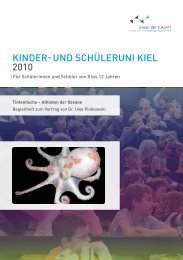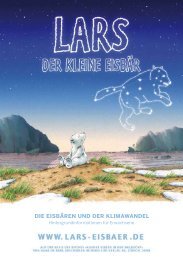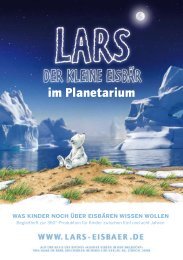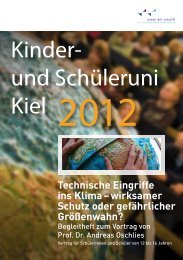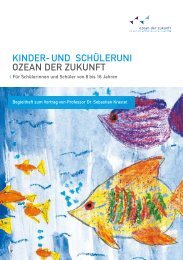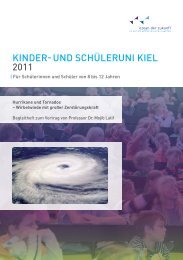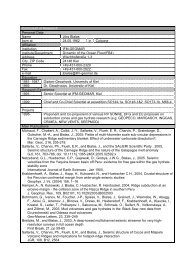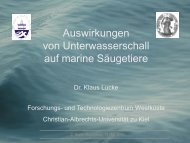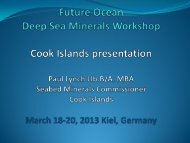Untitled - The Future Ocean
Untitled - The Future Ocean
Untitled - The Future Ocean
- No tags were found...
You also want an ePaper? Increase the reach of your titles
YUMPU automatically turns print PDFs into web optimized ePapers that Google loves.
B5(1) Sea-Level Rise and Physical-Morphological Changes in Coastal Seas2. State-of-the-artChanging sea levels have been the driver of shoreline changes over geological time. <strong>The</strong> overallglobal rate of SLR during the past 100 years has been nearly 2 mm/yr, distinctly higher than theaverage rate during the past millennia (Church and White 2006), and may further accelerate in thefuture (Overpeck et al. 2006). Extreme events, such as storms, peak freshwater run-off ortsunamis, further increase the impact of SLR on coastal vulnerability. Coastal water processes arestrongly affected by land-derived, ocean-derived and atmospheric loads. New global balances ofsediment discharge from rivers simultaneously show increases through soil erosion, but reductionsin sediment flux which reaches the world’s coasts because of retention within reservoirs (Syvitski etal. 2005). Hydro- and morphodynamic processes which act at the various land-sea interfaces overvarying timescales (from single events to centuries) have been studied separately, but the interplaybetween these processes is mainly responsible for triggering major coastal hazards (Ericson et al.2006). An improved understanding of the physical processes which control sediment fluxes andbudgets is needed because these processes induce major coastal changes and risks to society(Crossland et al. 2005, Pickrill and Todd 2003).3. Previous and on-going work of the proponentsExpertise in Kiel encompasses both, coastal geology and marine geophysics. Principal researchtopics include late Quaternary sea-level change and coastal evolution, as well as current hydroandsediment dynamics in the North and Baltic Seas and in the tropical coastal seas off Brazil,Madagascar, Vietnam and Malaysia (Caldas et al. 2006, Diesing et al. in press, Hanebuth et al.2000, Schwarzer et al. 2003). This research is linked to international programs (e.g. LOICZ, EUFramework Programs). Expertise in marine geophysics includes shallow-reflection seismology,satellite altimetry and gravimetry (TIPTEQ Project, SPP 1257: Mass Transport in the EarthSystem), shallow-water acoustic archeometry and engineering geophysics based on Scholte waveanalysis (Rabbel 2006). In-situ observations and measurements are supported by the ScientificDiving Group established at the Institute of Geosciences of the University of Kiel and the mannedsubmersible JAGO provided by P4.4. Objectives<strong>The</strong> proponents and the new JRG will study the interaction of the three coupled interfaces: landsea,freshwater-saltwater, and water column-seafloor. Water column, seafloor, and subsurfacestructures in coastal seas will be jointly investigated to integrate information on sediment mobility,deposition and erosion, as well as on migrating freshwater/saltwater boundaries and mixing zones.<strong>The</strong> primary objective is to quantify major physical-morphological changes in river-mouth systemsand adjacent coastal seas which are triggered by rising sea levels. This will provide reliable datafor various coastal threat scenarios.High-resolution hydroacoustic and shallow-reflection seismic techniques will be adapted forsurveying and imaging complex 4-D hydrodynamic structures and sediment fluxes in the water82


